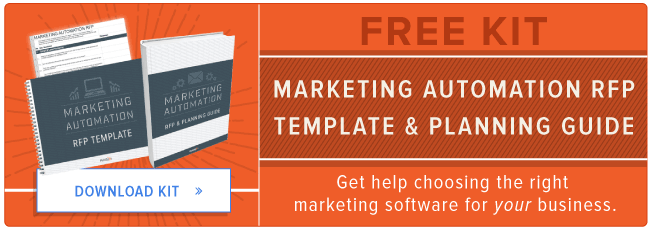 Recently, I came across a really depressing statistic about the marketing automation buying process: According to a study done by VentureBeat, 70% of marketers who purchase a system are either unhappy or only marginally happy with their software. But even though marketers are unhappy with their purchases, they’re still pumping serious cash into the marketing automation industry — it’s projected to be a $1.9 billion industry by 2020.
Recently, I came across a really depressing statistic about the marketing automation buying process: According to a study done by VentureBeat, 70% of marketers who purchase a system are either unhappy or only marginally happy with their software. But even though marketers are unhappy with their purchases, they’re still pumping serious cash into the marketing automation industry — it’s projected to be a $1.9 billion industry by 2020.
So if your company is following industry trends and planning to invest time and resources in marketing automation, how can you make sure you’re not going to be part of that unsatisfied 70%?
Part of the answer is to ask the right questions during the software selection process. Too often, Request for Proposals (RFPs) ask hundreds of questions, but don’t actually help marketers choose the best platform for their organization. Here are some examples of the best and worst questions you can ask in a marketing automation RFP. (And if you’re looking for more help with your RFP, check out this free RFP template and planning guide.)
The Worst Questions to Ask
1) Does your platform do this in that screen?
There are so many forms of this question. A favorite of mine is: “Do you have drag and drop functionality in (insert screen here)?”
This questions is like the “Pick a Side” ads from Twix, where the company supposedly splits in half, one making the right side of the bar and one the left. They satirize the difference between being “cloaked” vs. “covered” in chocolate and “flowing” caramel on to the cookie vs. “cascading” caramel on to the cookie. In one ad, a young executive suggests a merger between the two halves because they make the same thing and the obtuse executive interrupts him — “No, cloaked in chocolate, totally different process.”
Of course you want the software to be easy to use and the UI does impact that. But when evaluating RFPs, too many focus on asking if the software can do something in a very specific way. Being this prescriptive about the design or getting into a feature war between one vendor and another won’t lead to selecting the right marketing platform.
Instead, ask about ease of use and how the software will help you meet your goals — like driving leads, conversions, and customers. Even better, ask for a trial so you can see how firsthand how the tools work.
2) What percent of revenue do you invest in product development?
This question does not help you choose the right vendor. A company can invest 100% of their revenue in product development and release new features once a year. And they might not be features that you need or want. Getting an arbitrary percentage from each vendor is not the right question for an RFP.
Instead, what you really want to know is how the vendor decides on new product features, if they are forward-looking, how their vision aligns with your goals, and how often they release new features.
Knowing how customer input is handled will also tell you a lot. Imagine you’re looking at software and the company says they’ve implemented changes based on customer feedback over the past year — and has given you specific examples of those features. That tells you that they listen to their customers and if there is a popular feature request, you likely won’t be waiting around for years to get it.
3) How many reports can I create?
We’ve all heard the adage “It’s about quality, not quantity.” This is especially true in the reporting features of marketing automation software. In some systems, you can create literally thousands of reports that measure just about anything. But most marketers have limited resources and don’t have the time to spend pouring through endless reports. Besides, it’s what you do with the data that really matters.
So instead of focusing on the number of reports you can create, find a platform that enables you to make decisions about the success of your programs and channels. A good marketing software platform should help you understand where to invest your marketing resources, the ROI of your marketing programs, and the impact your marketing programs have had on revenue.
A great way to test this is to identify your biggest reporting problem area, and ask your vendor to show you an example report from their software that could deliver actionable insights to overcome the issue.
4) Can you do real-time personalization?
You’re probably thinking … wait a minute. Personalization is important, right? Yes. At HubSpot, in a study of over 93,000 calls-to-action (CTAs), we found that personalized CTAs performed 42% better than standard, static CTAs. A Janrain study found that nearly 75% of online consumers get frustrated with websites when the content has nothing to do with their interests.
But ‘real-time personalization’ is an industry buzzword, and this question doesn’t get you the information you need. If you want to personalize a CTA, for example, of course you want it to be ‘real-time’ in the sense that you want the personalized content to show up on the page when the person gets there. What’s the alternative?
You should find out, instead, if the platform offers personalization capabilities. You also need to know how easy they are to implement (Do you need to code? Get IT involved?), what attributes you can personalize on, and what type of content can be personalized. For example, can emails, landing pages and CTAs be personalized? Can the solution personalize your website for first-time visitors?
The Best Questions to Ask
1) How will you help us grow our database?
23% of all email lists expire every year. So even if you have a big list to start, it’s critical to continue to grow that list. How do you do that? Through content creation, blogging, SEO, and robust social media tools that help spread your message throughout the web. Ask if these tools are included or integrated with the potential marketing platform. Find out how the platform will help you grow your database, not just market to the existing one.
2) How easy is it to create assets for my marketing programs and make changes to them (emails, landing pages, etc.)? Do I need to know HTML or CSS? What about for mobile optimization?
This is a critical topic. The more landing pages you have, the more leads you can bring in and the more you can learn about those leads. If it takes hours to build a single landing page, or you need coding skills to make it look beautiful or be responsive, you won’t have time to focus on your goals. Or, you won’t end up using the system to it’s full capability because it’s too hard. One HubSpot customer talked about waiting until the end of the day to log into his marketing automation system because he “dreaded” logging into it.
And if you’re building landing pages and emails that aren’t optimized for mobile devices, you’re missing out on conversions, and you could be hurting your SEO efforts. It’s now being rumored that Google will soon be incorporating mobile user experience into its ranking algorithm. One Google study found that 52% of consumers are less likely to engage with a company if they’ve had a bad mobile experience.
Will the platform you choose offer landing pages and emails that are mobile-optimized or responsive by default? Can you preview content across various devices? A system that is built responsive can save you time, dollars, and help increase your conversion rates.
3) What is the CRM integration process like?
CRM integration is important for marketing and sales alignment and for supporting the sales process. You want a bi-directional sync between the two systems. Also, ask about what it takes to integrate your CRM. Do you need technical knowledge to do so? How much help does the vendor provide? This is a critical part of the process and you want to make sure you are fully supported.
4) How easy is it to measure the effectiveness of your marketing — and quickly act on it?
Understanding the platform’s reporting capabilities is key to ensuring that you can make data-driven decisions about marketing spend and show your leadership team actionable results. This can get tricky because with the sheer amount of data available to you in most systems, you can lose time analyzing metrics that don’t actually help you make decisions. Instead of focusing on every report you could ever possibly want to build, focus on your top goals and find out how quick and easily you can report on success.
Here are some examples of what you should be able to do in your marketing automation system:
- You’re marketing across multiple channels — paid, social, email, events, etc. You should be to understand which channels are driving the most visits, leads, and customers.
- If you’re using campaigns, you should easily be able to tie assets to a campaign and report on individual assets and the overall campaign — both at the end and while the campaign is running.
- Tie your marketing efforts back to the deals and revenue generated for the company.
And here is where ‘real-time’ is important. You shouldn’t have to wait until the end of a campaign, export data, build Excel formulas, figure out what happened, and then take action on your next campaign. You should be able to see which channels/initiatives are working (and which ones aren’t), and fix them mid-campaign.
5) When you have issues, how easy is it for anyone on your team to get support?
I can’t stress the importance of this enough. Does the vendor provide unlimited and free access to web, phone, email, and Twitter support? Or does that cost extra? How many people on your team can engage with support? Is it limited? How long can you expect to wait on hold if you call in with an issue? Are you given a single point of contact for your entire customer lifetime? If you bring on new team members, do you have to pay extra to train them? Does the vendor offer personalized training?
A marketing automation system or software platform can be very powerful — as long as you’re actually using it. Having quality customer support from the platform vendor is critical to this. Too often, this costs extra, or it takes too long to find the answer you need. You’re implementing marketing automation so you can generate results. Don’t let a poor support experience get in your way.
In general, remember to stay focused on what your goals are — they’re probably around driving more visits, leads, customers, and revenue — and on how the system you’re putting in place will help you get there. To help with this, we’ve put together an RFP template and planning guide that asks the right questions about growing your database and nurturing your leads, so you can choose the vendor that makes the most sense for your organization.
![]()







